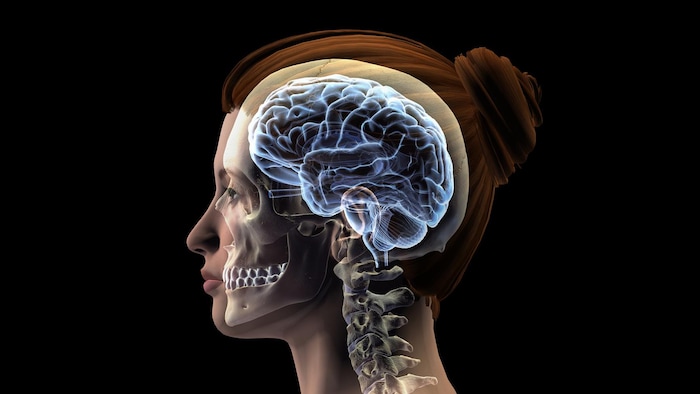Open full screen Research from Cambridge University examines the origins of myelin, an insulating fatty membrane that forms around nerves and allows electrical impulses to travel more quickly. (Archival illustration of the human brain) Agence France-Presse Ancient viruses that infected vertebrates hundreds of millions of years ago played a crucial role in the ;evolution of our bodies and our brains, shows a British study published in the journal Cell (New window) (in English). This research from Cambridge University examines the origins of myelin, an insulating fatty membrane that forms around nerves and allows electrical impulses to travel more quickly. According to the authors, a genetic sequence acquired from retroviruses – viruses that invade their host's DNA – is crucial for the production of myelin. And this code is found today in modern mammals, amphibians and fish. What I find most remarkable is that all this diversity of known modern vertebrates, and the size they have reached – elephants, giraffes, anacondas… – would not have happened without the infection of these retroviruses, neuroscientist Robin Franklin, co-author of the study, told AFP. p> Researchers searched genome databases to try to uncover genetic factors associated with myelin production. Loading ELSE ON NEWS: Attack stabbing in Vaudreuil-Dorion: two women are dead and another injured Tanay Ghosh, a biologist and geneticist who works with Franklin, was particularly interested in the mysterious non-coding regions of the genome, which have no apparent function and were at one time considered useless, but which now recognizes its importance in evolution. His research led to a sequence derived from a retrovirus, which has been found for a long time in our genes, and which researchers have named RetroMyelin. To verify their discovery, they carried out experiments consisting of deleting this sequence in rats. They then observed that they no longer produced a certain protein necessary for the formation of myelin. The scientists then looked for similar sequences in the genomes of other species and found similar code in jawed vertebrates – mammals, birds, fish, reptiles and amphibians – but not in jawless vertebrates or invertebrates. . They concluded that the sequence appeared in the tree of life around the same time as jaws, that is x27;that is, about 360 million years ago. The study was called a fascinating insight into the history of our jawed ancestors by Brad Zuchero of Stanford University, who was not involved in the work. p> There has always been selection pressure to make nerve fibers conduct electrical impulses faster, Robin Franklin pointed out. By doing that faster, then you can act faster, he explained, which is useful for predators or for prey trying to escape from them. Myelin allows rapid conduction of these signals without increasing the diameter of nerve cells, allowing them to be brought closer together. It also provides structural support, meaning the nerves can grow further, allowing the development of larger limbs. In the absence of myelin, invertebrates have found other ways to transmit electrical signals quickly: giant squid, for example, are equipped with larger nerve cells. Finally, the team of researchers wanted to understand whether the viral infection had occurred once, in a single ancestral species, or several times. To answer this question, they analyzed RetroMyelin sequences from 22 species of jawed vertebrates. These sequences were more similar within a species than between different species. This suggests that multiple waves of ;infection occurred, having contributed to the diversity of vertebrate species known today, according to the researchers. We tend to think of viruses as pathogens, agents causing disease, noted Robin Franklin. The reality, however, is more complicated, according to him: At different times in history, retroviruses entered the genome and integrated into the reproductive cells of species, allowing them to be passed on to subsequent generations. One of the best-known examples is the placenta – a characteristic of most mammals – acquired from a pathogen integrated into the genome a long time ago. For Tanay Ghosh, this discovery on myelin could only be a first step in an emerging field. There is still much to understand about how these sequences influence different evolutionary processes, he said.
Knife attack in Vaudreuil-Dorion: two women are dead and another injured
The role of ancient viruses in brain development

